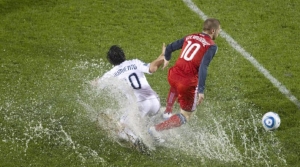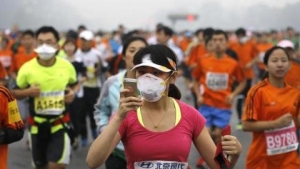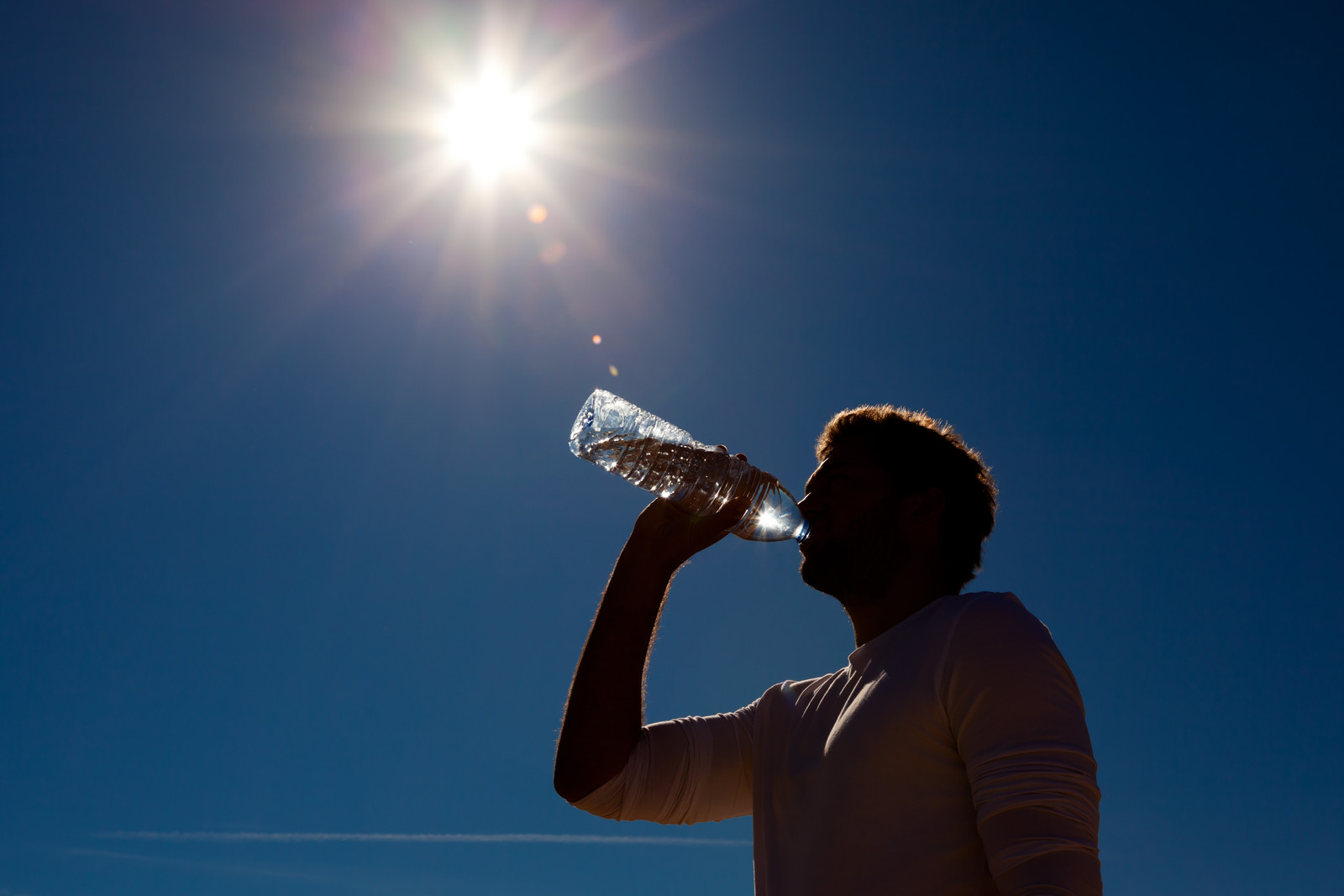Climatic conditions refer to the environmental temperature, humidity, wind, rain, altitude, and pollution levels. Each of these conditions affects athlete safety and need to be considered in order to enhance the wellbeing of the athlete.
Temperature
There are two (2) ways that the environmental temperature can be dangerous to an athletes wellbeing: too hot and too cold.
The impact of hot climatic conditions on safe sports participation
Hot weather can be dangerous to the athlete. Every movement an athlete makes uses ATP by breaking into ADP and P while releasing energy as both movement and heat. This heat needs to be removed from the body for safety. However, on hot days the athlete will also gain heat from the environment.
Hot climatic conditions add heat to the athlete particularly through radiation. This places the athlete at higher risk of hyperthermia and heat stroke. Hot conditions make it more difficult for the athlete to maintain their body temperature, and force the athlete to sweat more, which can lead to dehydration. It is therefore vital that the athlete have strategies to help the body lose heat through temperature regulation mechanism.
Strategies such as pouring water over the body, wearing light lose clothing, and doing physical activity in the cooler times of the day and out of direct sunlight if possible, will help maintain safety. If weather is too hot, then the event should be rescheduled if possible.
The impact of cold climatic conditions on safe sports participation
 Cold conditions may result in the athlete losing too much heat and the body temperature dropping to unsafe levels. Athletes will sweat and send blood supply to the skin in order to lose heat when exercising. But, if this occurs when the weather is cold, they can lose too much heat. The body may respond by reducing sweat levels and keeping the blood away from the skin, but heat will still be lost.
Cold conditions may result in the athlete losing too much heat and the body temperature dropping to unsafe levels. Athletes will sweat and send blood supply to the skin in order to lose heat when exercising. But, if this occurs when the weather is cold, they can lose too much heat. The body may respond by reducing sweat levels and keeping the blood away from the skin, but heat will still be lost.
There are many sports that are conducted in cold environments, such as: ice-hockey, skiing, and bobsledding. Other sports, such as football, are played in winter when it can be very cold, or even snow. A such athletes need to have strategies to maintain a safe body temperature. These could include: wearing long sleeves, or warm clothes such as snow jackets and pants, as well as ensuring the athlete does not stand around in the cold waiting. Athletes would also benefit from longer warm ups to prevent injury.
Humidity
The impact of humid climatic conditions on safe sports participation
Humidity refers to the water concentration in the atmosphere. The more concentrated or humid the climatic conditions the less effective sweat and evaporation is at removing heat. Since this is our bodies main temperature regulation mechanism, it places the athlete in danger, especially if the weather is hot.
How the combination of heat and humidity increases the likelihood of hyperthermia
Hot humid conditions greatly increase the likelihood of hyperthermia because the body’s temperature regulation mechanisms are hindered and heat loss is minimal. If the athlete is producing heat by doing physical activity this heat will not be lost and the athlete may suffer hyperthermia. This is particularly likely because evaporation is impaired by the increased humidity. In a hot environment the athlete will lose less heat through radiation and is more likely to gain heat through this mechanism. Conduction may work, if the breeze is cool, but a warm breeze can add further heat to the athlete. Finally, many surfaces will also be warmer than the body, meaning conduction will result in heat being transferred to the body not away from it.
Strategies must be in place to assist he bodies temperature regulation mechanisms in order for safe participation to occur. The availability of cold water and ice, particularly an ice-vest would greatly assist the athlete to maintain a safe body temperature. Adequate fluid consumption will also help avoid dehydration in these conditions.
Wind
The impact of windy climatic conditions on safe sports participation
Windy climatic conditions greatly increases the loss of heat through convection, though a warm wind will add heat to the athlete rather than removing it. Wind will also affect the movement of equipment such as balls, which can make play more dangerous as the ball can move unexpectedly and injury a player.
How the combination of cold and wind increases the likelihood of hypothermia
Cold windy climatic conditions greatly increases the likelihood of hypothermia. Cold conditions cause greater heat to be lost through radiation, conduction and convection. Wind further increases the heat loss through convection and places the athlete at greater risk of hypothermia.
Athletes need strategies in order to regulate their temperature regulation mechanisms and maintain heat. This can be done through the wearing of appropriate warm clothing, such as jackets, pants or skins to reduce wind contact wit the skin and therefore reduce heat loss through convection. Warm clothing will also prevent some heat loss from evaporation. Other strategies to maintain body temperature include: having a longer warm up, continuing to move in order to generate heat, having warm water available to drink (not to put not eh skin, where it sill cool), and by ensuring the athlete removes sweat or water with a towel to reduce heat loss by convection and evaporation.
Rain
The impact of rainy climatic conditions on safe sports participation
Rain increases the heat lost through convection as water moves across the surface of the skin. This can be particularly dangerous if it occurs in cold and/or windy climatic conditions. Water that sits on thespian will also conduct heat away from the body.
However, rain also means that the humidity in the air is high. If rain occurs on a ho t day, it will reduce the heat lost through evaporation, however the increased heat lost through convection should more than make up for this.
t day, it will reduce the heat lost through evaporation, however the increased heat lost through convection should more than make up for this.
Rainy conditions also make surfaces slippery, therefore increasing the risk of injury to a player. Many sports such as netball will be cancelled if the courts get wet, as play becomes to dangerous to the athlete.
Altitude
The altitude at which a sport or physical activity is conducted will influence player safety. This is because there are different oxygen concentrations in the air at varying altitudes. The higher the altitude the lower the oxygen concentration, the lower the altitude the greater the concentration.
This is because the air at lower altitudes has the pressure of all the air above it pushing down on it forcing the molecules closer together, and the higher altitude molecules have less other air on top of it, to they can spread out more. This is often spoken of as air pressure. The greater the air pressure, the higher the concentration of air molecules, with oxygen being one of those molecules. A similar thing happens with water and is why you can feel your goggles or face mask push against your face as you dive deeper underwater.
High altitude has other affects on the athlete as well. For example, there is greater radiation from the sun at higher altitudes, placing the athlete at greater risk of sun burn. Sunscreen should be used. Another example, is the increased ability to jump. With less molecules on your shoulder, there is less resistance to vertical movement, allowing the athlete to jump higher.
The impact of altitude on safe sports participation
The result of the varying altitude levels is that if an athlete has been doing physical activity at a low altitude and is then required to perform at a high altitude, their performance will decrease because they less oxygen moving into their blood and being transported to the muscles. Less oxygen available int he air, means less oxygen in the blood. Because of this, many athlete will try and acclimatise to the location of their competition 2-4 weeks before competition.
Acclimatisation is when the athlete arrives before competition, normally at a higher altitude in order to adapt to the lower concentrations of oxygen in the air. The physiological adaptation that occurs, is an increase in haemoglobin, which increases the amount of oxygen in the blood at the higher altitude allowing for an improved performance. If an athlete does not acclimatise to the higher altitude, them may experience hypoxia, which means they do not have enough oxygen and will will get dizzy, light headed and lose their balance. hypoxia can be life threatening.
The affects of high altitude have also been used in training programs. Some athletes will do what is called “live high train low”. This is where the athlete lives at high altitude (either simulated or real) in order to increase their haemoglobin levels, but then train at low altitude, where training can still be done at high intensities. This gives the aerobic athlete an increase in performance as they have greater oxygen transport available to maintain higher intensities for longer, with less waste product.
Pollution
Pollution is a climatic condition that refers to the presence of contaminants either in the air or the greater environment. The one of most concern for the athlete is air pollution, since they are breathing deeply and frequently as they exercise.
Analyse the impact of pollution climatic conditions on safe sports participation
 Pollution can cause health concerns depending on the contaminant. Some contaminants have been linked with cancer, chronic bronchitis, or other issues such as asbestosis. However, some contaminants pose fairly minor dangers to the athlete, especially if exposure is minimal.
Pollution can cause health concerns depending on the contaminant. Some contaminants have been linked with cancer, chronic bronchitis, or other issues such as asbestosis. However, some contaminants pose fairly minor dangers to the athlete, especially if exposure is minimal.
There are few strategies an athlete can use to enhance safety when pollution is present, other than not participating, or wearing a mask.

